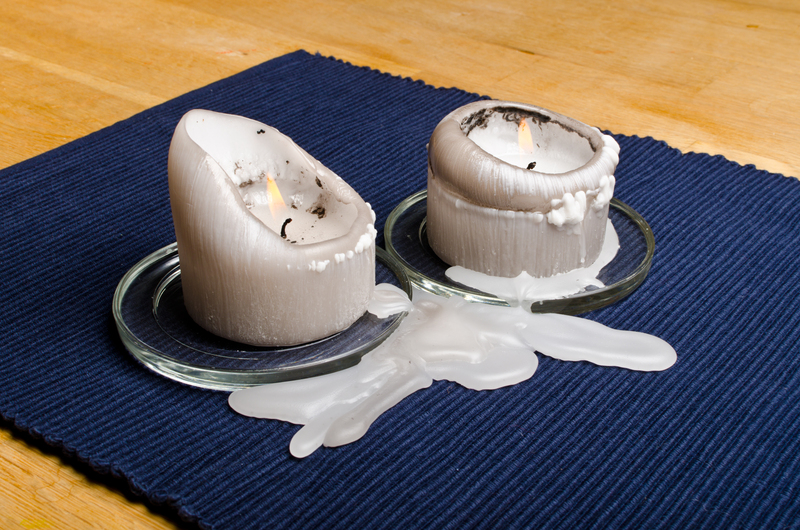Creating healthy habitats: The significance of indoor air quality
Posted on 03/10/2025
Creating Healthy Habitats: The Significance of Indoor Air Quality
Understanding the Importance of Indoor Air Quality
In today's fast-paced, urbanized world, people spend a staggering 90% of their time indoors. Whether at home, work, or school, the quality of the air inside these spaces--known as indoor air quality (IAQ)--has a profound impact on health, productivity, and well-being. Yet, the significance of indoor air quality often goes unnoticed, overshadowed by visible aspects of cleanliness and comfort.
This comprehensive guide will provide in-depth insights into why maintaining clean, healthy indoor air is crucial, the common sources of indoor air pollution, health effects, and practical strategies for creating optimal living and working environments.

Why Indoor Air Quality Matters More Than Ever
Modern lifestyles have transformed the way we interact with our environments:
- Urbanization has led to tightly sealed buildings for energy efficiency, but these can trap pollutants inside.
- Outdoor pollution often finds its way indoors, impacting those who believe they're safe inside.
- Remote work and learning increase the time families spend indoors, intensifying exposure to indoor contaminants.
Healthy habitats depend heavily on the air we breathe within our walls.
Key Aspects of Indoor Air Quality
- Airborne pollutants: Includes dust, pet dander, pollen, chemicals, and more.
- Humidity and moisture: Excess humidity promotes mold and dust mites.
- Ventilation: Proper air exchange dilutes and removes indoor contaminants.
- Temperature: Comfort and air movement affect perceived air freshness.
Main Sources of Indoor Air Pollution
To create a truly healthy indoor environment, it's important to know where pollutants originate. Here are the primary contributors to poor indoor air quality:
1. Biological Pollutants
- Mold spores: Thrive in damp areas like bathrooms and basements.
- Pollen: Enters through windows and doors, triggering allergies.
- Pet dander: Small, airborne skin flakes shed by animals.
- Bacteria and viruses: Can spread through HVAC systems or person-to-person contact.
2. Chemical Contaminants
- Volatile Organic Compounds (VOCs): Found in paints, cleaning products, furnishing materials, and office equipment.
- Formaldehyde: Off-gases from pressed-wood furniture and some fabrics.
- Pesticides: Residues from indoor and outdoor use accumulate in dust.
- Tobacco smoke: Contains over 7,000 chemicals, many carcinogenic.
3. Particulate Matter
- Fine dust: Resulting from outdoor air, construction, or cleaning activities.
- Cooking smoke: Especially from burning oil and improper ventilation.
- Soot and ashes: From fireplaces, candles, or incense.
4. Gaseous Pollutants
- Radon: Radioactive gas seeping from soil, a leading cause of lung cancer.
- Carbon monoxide: Produced by faulty appliances like heaters and stoves.
- Nitrogen dioxide: Emitted by unvented gas stoves and heaters.
Understanding these sources is the first step in controlling and improving your indoor air quality for a healthier habitat.
Health Impacts of Poor Indoor Air Quality
While the effects of smog and outdoor pollution are widely recognized, indoor air pollution can be up to five times worse than outdoors, according to the U.S. Environmental Protection Agency (EPA). The health consequences are varied and can be severe, especially for vulnerable groups such as children, the elderly, and those with chronic illnesses.
Short-Term Health Effects
- Eye, nose, and throat irritation
- Headaches and dizziness
- Exacerbation of allergies or asthma
- Fatigue and difficulty concentrating
Long-Term Health Risks
- Respiratory diseases: Asthma, chronic obstructive pulmonary disease (COPD), bronchitis
- Increased risk of cancer: Especially from radon, tobacco smoke, and chemicals like formaldehyde
- Cardiovascular effects: Linked to chronic exposure to fine particulate matter
- Immune system suppression and developmental impacts in children
Maintaining a clean indoor atmosphere is therefore integral to disease prevention and lifelong wellness.
Signs Your Indoor Air Quality May Be Poor
Recognizing the signs of subpar indoor air quality is crucial before undertaking any remediation steps:
- Persistent musty or chemical odors
- Frequent respiratory symptoms among occupants
- Visible mold growth or excessive dust buildup
- Unexplained fatigue, headaches, or allergic reactions
- Condensation or humidity on windows and walls
Strategies for Improving Indoor Air Quality
There are several actionable, evidence-based steps you can take to boost the air quality in your home or office:
1. Increase Ventilation
- Regularly open windows and doors: Especially during mild weather, to promote fresh air circulation.
- Utilize exhaust fans: In kitchens, bathrooms, and laundry rooms to remove moisture and contaminants.
- Install mechanical ventilation systems: Such as energy recovery ventilators (ERVs) or heat recovery ventilators (HRVs) for continuous air exchange in sealed buildings.
2. Control Pollution Sources
- Use low-VOC products: Select paints, cleaning products, and furnishings with minimal chemical emissions.
- Prohibit smoking indoors: Even occasional smoking introduces persistent toxins into fabrics and air ducts.
- Maintain fuel-burning appliances: Annual inspections can prevent carbon monoxide and nitrogen dioxide leaks.
- Store chemicals safely: Keep pesticides, solvents, and other hazardous materials in well-ventilated or outdoor spaces.
3. Manage Humidity and Moisture
- Use dehumidifiers in damp areas: Keeping humidity between 30-50% discourages mold and dust mites.
- Fix leaks promptly: Pipes, roofs, and basements should be checked for water intrusion.
- Regularly clean and dry bathrooms and kitchens: These spaces are prone to moisture buildup.
4. Improve Housekeeping Practices
- Vacuum frequently: Use a HEPA filter-equipped vacuum cleaner to trap fine particles.
- Dust with damp cloths: Dry dusting can simply redistribute particles into the air.
- Wash bedding and drapes regularly: These textiles accumulate allergens over time.
5. Incorporate Air Purification
- Invest in an air purifier: With a HEPA filter and activated carbon for maximum effectiveness against both particles and odors.
- Maintain HVAC systems: Change filters regularly and schedule professional duct cleaning to avoid recirculating dust and mold.
- Add houseplants carefully: Some plants may help remove certain gases, though they are not a substitute for proper ventilation and cleaning.
The Role of Monitoring in Maintaining Good Indoor Air
To ensure ongoing indoor air quality, active monitoring is recommended. Affordable digital monitors can alert you to the presence of radon, carbon monoxide, and rising air pollution levels, enabling quick responses before problems become serious.
- Install carbon monoxide detectors on every floor, especially near bedrooms.
- Test for radon using professional kits or through local health departments.
- Track humidity and temperature trends with smart home sensors.
- Consider IAQ monitors that measure VOC levels and particulate matter in real-time.
Ongoing vigilance ensures your habitat remains safe, healthy, and comfortable for all occupants.
Indoor Air Quality and Productivity
The significance of indoor air quality goes beyond health. Research shows that even modest improvements in air purity can:
- Enhance cognitive function and focus
- Reduce absenteeism in schools and workplaces
- Boost overall productivity levels
- Create a more pleasant, energetic atmosphere
Clean air thus supports not only individual well-being but also economic and educational success.
Implementing these measures creates a positive feedback loop--happier, healthier occupants contribute to more vibrant and successful communities.
Special Considerations for Sensitive Groups
Certain individuals are especially vulnerable to indoor air pollution, including:
- Children and infants
- Older adults
- People with allergies, asthma, or respiratory diseases
- Pregnant women
For these groups, maintaining a clean and uncontaminated indoor environment is especially important. Simple interventions--like using allergen-proof bedding, avoiding indoor smoking, and installing effective air filters--can make a significant difference in daily quality of life and long-term health.

Future Trends in Indoor Air Quality Management
As awareness of healthy habitats grows, new technologies and design philosophies are shaping the future of indoor environments:
- Smart home integration: Automated IAQ monitors can control HVAC systems, purifier operation, and humidity regulation based on real-time data.
- Green building certifications: Standards like WELL and LEED prioritize good indoor air as part of sustainable design.
- Natural ventilation design: Architectural approaches harness airflow for fresh, clean air with minimal energy use.
- Continued research into the health impacts of emerging contaminants and solutions.
Prioritizing indoor air quality is becoming a cornerstone of environmental stewardship and future-forward living.
Conclusion: Breathe Easier--The Time to Improve Indoor Air Quality is Now
Creating healthy habitats begins and ends with the air we breathe. From the office boardroom to the family living room, every indoor space has the potential to support or sabotage our mental and physical well-being. By understanding the sources of indoor air pollution, recognizing symptoms of poor air quality, and applying practical solutions, you can take meaningful steps toward a safer, healthier, and more vibrant indoor environment.
Don't underestimate the significance of indoor air quality. With simple, sustainable habits and attention to detail, you can nurture a truly healthy habitat--one breath at a time.
For ongoing updates and professional guidance, consult resources from the EPA, WHO, and indoor air quality professionals in your area. Prioritize clean air today and enjoy the rewards of a healthier tomorrow!





